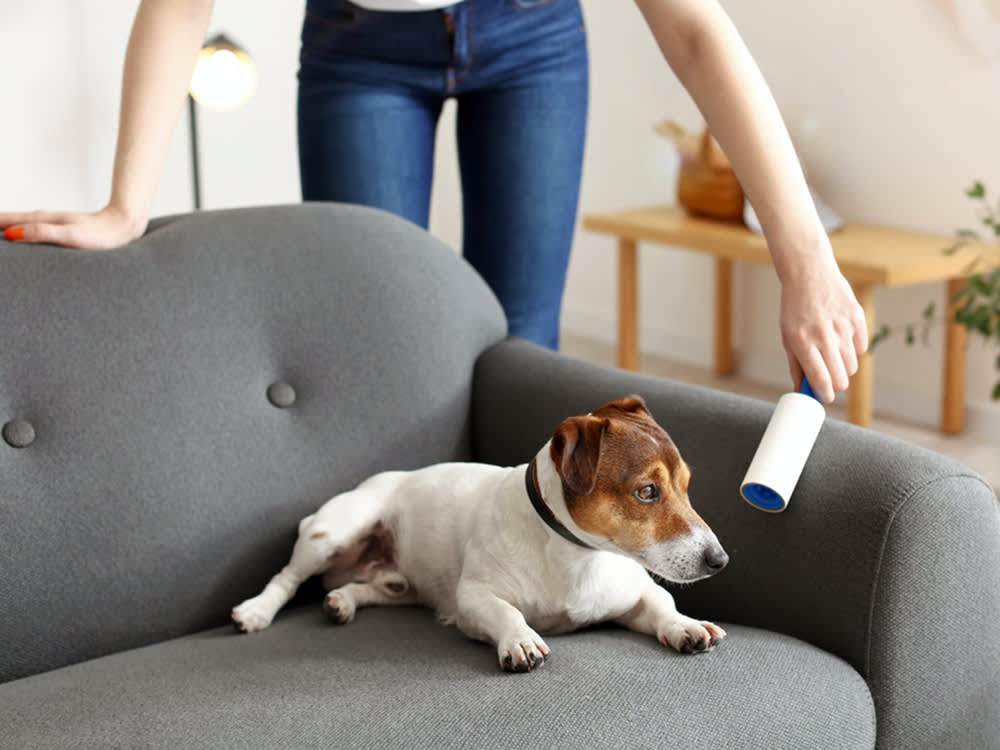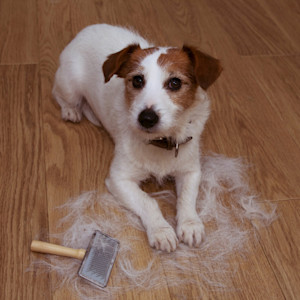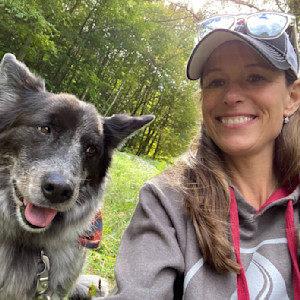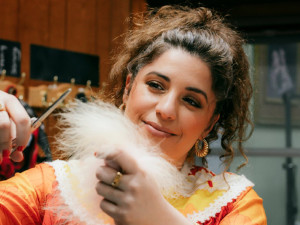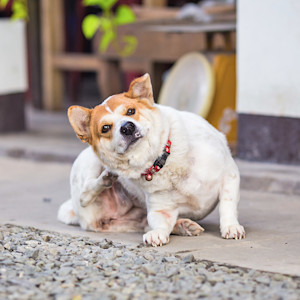Shedding Season: How to Keep Dog Hair Off Your Couch, Car, Clothes, and Carpet
Yes, you can: Here are some tips on keeping your house clean, despite your pup’s endless shedding.
In This Article:
Why Is My Dog Shedding? Brushing, Bathing, and Grooming Food and Water Can Reduce Shedding How to Clean Up Dog Hair
Every season seems to be shedding season in my house. My long-haired Border Collie mix, Willy, has a fluffy coat that sheds tumbleweeds year-round. His littermate Lilac, meanwhile, has a short, thick coat that deposits drifts of Oreo-colored hair everywhere. It’s how I know she sleeps on the couch when I’m not home.
Dogs shed for various reasons, including their breed, age, hormonal cycle, and the time of year. Understanding the reasons for this can help you determine if the amount they’re shedding is normal, or if your dog needs veterinary attention. In most cases, a regular brushing routine with dog hair-removal tools and some disciplined house cleaning will keep you from losing your hair.
Trick question: All dogs are perfect! But find out which type is the best fit for you.
Why is my dog shedding?
Dr. Jim MacLean, chief veterinarian at the dog grooming company Scenthoundopens in new tab, says shedding is a natural part of a dog’s hair cycle. In fact, shedding promotes healthy hair growth. “Certain dog breeds like Golden Retrievers, Labrador Retrievers, and German Shepherds are more prone to shedding,” MacLean says.
How much do you spend on your pet per year?
However, he notes that it’s important for pet parents to recognize what’s normal and what may indicate a health issue. Seasonal and food allergies, also called atopic dermatitis, are among the top reasons dogs lose hair. They lead to itching that, in turn, can cause hair loss. “Food allergies, dryness, and a change in diet are major contributors,” MacLean says.
Health issues
Lorraine Rhoads, the director of health and safety at Dogtopiaopens in new tab, spent years managing veterinary hospitals following the rigorous standards of the American Animal Hospital Association (AAHA). She recommends visiting your vet if you notice your dog’s coat thinning or falling out, if you see patches of hair loss, or if their skin looks irritated. “Your vet will want to investigate allergies, diet, ringworm, hormonal conditions, or other health concerns,” Rhoads says.
Parasites
No one wants ticks, fleas, and mites on their dog — or in their home. Your dog doesn’t like them either and will scratch to remove them. In extreme cases, this can lead to hair loss. “Regular parasite prevention is not just about preventing disease and keeping your dog from scratching all night,” Rhoads says. “It can keep their coat healthy, too. Fleas, ticks, and mites can cause excessive scratching, which can lead to hair falling out.”
Stress
Stress can exacerbate shedding. “New environments, loud noises, unknown people, a trip to the veterinarian…can all make a dog drop some hair,” Rhoads says. “By paying attention to when your dog’s shedding worsens, you can identify a stress trigger.”
Seasonal shedding
This may be the likeliest reason for our war on dog hair. Rhoades says seasonal shedding in the spring and fall is normal. “It’s nature’s way of preparing your dog for warmer or cooler months,” she says.
Brushing, bathing, and grooming
Eunice Arauz owns the pet accessories store Pets Avenueopens in new tab and regularly helps pet parents manage shedding. “I know first-hand how frustrating it is when you have to manage excessive shedding,” Arauz says. She recommends high-quality de-shedding brushes, especially for double-coated breeds like Huskies. “In addition to removing hair from the home, I manage coat and skin health with specialized brushes,” Arauz says.
MacLean advises making a habit of brushing your dog once a day for even just a minute to remove itchy fur and dander, eliminate dirt, and redistribute the coat’s natural oils.
Rhoads agrees. “If you have a breed that sheds lots of hair, daily brushing can help keep the loose hair under control,” she says. “Each dog breed can be different when it comes to brushing frequency, but most dogs will benefit from a brush every one to two weeks to keep tangles away and remove excess hair that has fallen out of the follicle.”
There are a lot of brushes to choose from, but slicker brushes may be the most common, Rhoads says. “They are used for brushing out tangles, removing dirt or grass from a dog’s coat, and come in a variety of sizes,” she says. Read on for more specific suggestions and explore Kinship’s list of the 10 best grooming products.
Brushing
Short-haired
Contrary to what I (and maybe you) might have assumed, short-haired dogs shed more than long-haired dogs. At least in my house. MacLean advises a bristle brush or a mitt.
Medium-haired dogs
For medium-coat dogs, a brush with bristles and pins is most effective. “These pups benefit from rubber curry brushes, bristle brushes, or grooming gloves to help lift out loose fur and massage the skin without irritation,” Rhoads says. Curry brushes, she notes, are usually made of rubber and have short, rounded nubs to remove hair.
Long-haired dogs
“Our long-haired pups need more brushwork and will benefit from slicker brushes or pin brushes to prevent tangles and mats,” Rhoads says.
Double-coated breeds
Shedding rakes and combs are designed for dogs with a double coat as the soft-tipped pins can reach further into the coat and rake out loose undercoat hairs, Rhoads explains. “Huskies and Shepherds are good examples of double-coated breeds,” she says. “These pups need an undercoat rake to reach down deep and pull out the shorter, soft undercoat layer before it ends up all over your couch and black pants.”
Bathing
Schedule
Regular bathing removes loose hair before it falls out. Bathing every four to six weeks is recommended for most dogs, but this depends on their breed, coat, and lifestyle. “Mud-rolling retriever? You might be bathing more often,” Rhoads says. “Indoor couch potato? You can stretch it out.” Arauz recommends bathing most dogs every four weeks using a natural, pet-safe shampoo followed by a low-heat dog hair dryer to maintain coat shine and health. “It is of utmost importance to remember [that] regular bathing produces a dirt-deteriorating coat,” Arauz says.
Pet-friendly shampoo
Experts recommend pet-specific shampoo for good reason. “Human shampoo — even baby shampoo — is way too harsh for dogs’ skin,” Rhoads says. “Look for moisturizing, gentle formulas with natural ingredients like oatmeal, coconut oil, or chamomile.”
Low-heat drying
Likewise, avoid high-heat blow dryers because they dry out your dog’s skin and make shedding worse, Rhoads says. Use a dog hair dryer or a regular dryer on the lowest setting. No dryer? Thoroughly towel-dry your dog, and let them air dry in a warm, draft-free space.
Grooming
Matted hair
Brushes with softer bristles and detangling tools can help dogs with sensitive skin and hair that tends to mat (a form of extreme tangling). These dogs need more frequent bathing and brushing. “Dematting tools can help break apart a mat while protecting the skin,” Rhoads says, though serious mats should only be removed by a professional groomer or veterinarian.
Low-heat drying
Dogs can’t tolerate high-heat dryers. Commercial pet dryers have pet-friendly settings, but if you’re using a regular dryer, make sure it’s set to the lowest heat.
Pest control
There are many options to prevent tick and flea infestations. Regular grooming is another tool that detects and prevents outbreaks.
Food and water can reduce shedding
Proper nutrition can mitigate shedding, something to discuss with your vet if you suspect your dog’s shedding is diet-related. Nutritional deficiencies can occur from poor-quality dried foods or even well-intentioned but inappropriate home diets. They can be addressed by adding omega-3 and omega-6 fatty acids, high-quality proteins, zinc, and other minerals to your dog’s diet. Just be sure to consult your veterinarian before adding supplements to their diet.
Hydration
Ensuring your dog has a constant supply of fresh, clean water is crucial for overall health and prevents dehydrated skin, which exacerbates shedding.
Fatty acids
Omega-3 fatty acids are considered the healthiest fats for dogs. Found in fish oil products, they’re great sources of energy and keep hair and skin healthy, which in turn reduces shedding.
How to clean up dog hair
We’ve talked about the reasons for shedding and how to reduce it (and keep your dog healthy) with brushing, bathing, nutrition, and hydration. Despite all these measures, dog hair will still find its way onto your couch, clothing, and carpet. Arauz recommends a pet-hair vacuum, microfiber cloths, and rubber brushes to lift loose hair off furniture and remove dog hair from carpets.
“As a result of integrating these products and practices into my life, I have noticed the amount of loose hair in my living space has reduced by 25 percent,” she says. “The correct cleaning products, mixed with proper care, create a significant difference in handling shedding.” If you’re particularly resourceful, consider upcycling your pet hair or your friend’s pet’s hair. When spun into yarn, this can make a great gift for any knitter in your life.
Pet-hair vacuum
Pet-hair vacuum cleaners are designed to have powerful suction, advanced filtration, and brush rolls that resist hair-wrapping. Many regular vacuums have pet hair-specific attachments. “Vacuum often — more than you think you need to — with a HEPA filter and pet-specific attachments,” Rhoads says. Roomba and Roborock make robot vacuums for dog hair.
Rubber and static
Rubber gloves (the regular dishwashing kind) effectively remove hair from fabric, car upholstery, and carpets. “Just dampen them slightly, and run your hand over the surface,” says Rhoads. Another satisfying rubber hack is running a shower squeegee over your carpets, rugs, or fabric couches to remove excess hair. “This works especially well on stairs or along the edges of your carpet where the vacuum can’t reach,” Rhoads says.
Microfiber
Microfiber mops for hard floor surfaces attract and hold pet hair. Arauz also uses them on furniture. “I recommend microfiber cloths or rubber brushes to lift loose hair on furniture or carpets,” she says.
Lint rollers and tape
Many pet parents keep one of these inexpensive, reusable tools in their car to remove stray pet hairs from clothing. They’re great for quick couch cleaning and awkward spots like curtains. “Lint rollers and dryer sheets work wonders on furniture and clothing,” Rhoads says.
Felt
Felt dog hair removers work similarly to lint rollers for picking up dog hair.
Air purifiers
Dog hair and dander (dead skin cells) carry airborne allergens that in some households can only be managed with HEPA (high efficiency particulate air) cleaners.
References
“Barkoo & Co - Pet Grooming.” Barkooandco.com, 2025, www.barkooandco.com/blog/how-does-grooming-help-with-flea-and-tick-preventionopens in new tab.
Green, R., et al. “The Effect of Air Filtration on Airborne Dog Allergen.” Allergy, vol. 54, no. 5, 1 May 1999, pp. 484–488, https://doi.org/10.1034/j.1398-9995.1999.00029.xopens in new tab.
Morris, Daniel O. “Human Allergy to Environmental Pet Danders: A Public Health Perspective.” Veterinary Dermatology, vol. 21, no. 5, 30 Mar. 2010, pp. 441–449, https://doi.org/10.1111/j.1365-3164.2010.00882.xopens in new tab.
Watson, Tim D. G. “Diet and Skin Disease in Dogs and Cats.” The Journal of Nutrition, vol. 128, no. 12, 1 Dec. 1998, pp. 2783S2789S, https://doi.org/10.1093/jn/128.12.2783sopens in new tab.
